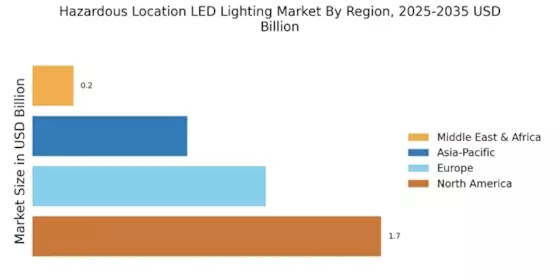Increased Focus on Workplace Safety
The Hazardous Location LED Lighting Market is significantly influenced by the heightened focus on workplace safety. Regulatory bodies and industry standards are increasingly mandating the use of appropriate lighting in hazardous environments to prevent accidents and ensure worker safety. This has led to a surge in the adoption of LED lighting solutions that meet stringent safety standards. For instance, the National Fire Protection Association (NFPA) and other organizations have established guidelines that promote the use of explosion-proof and weather-resistant lighting fixtures. Consequently, the market is expected to expand as companies invest in compliant lighting solutions to enhance safety and reduce liability.
Rising Awareness of Environmental Impact
The Hazardous Location LED Lighting Market is also influenced by the rising awareness of environmental impacts associated with traditional lighting solutions. As organizations become more conscious of their ecological footprint, there is a shift towards adopting LED lighting, which is known for its lower environmental impact. LEDs contain no hazardous materials, such as mercury, and have a longer lifespan, which reduces waste. This growing environmental consciousness is prompting industries to transition to LED solutions in hazardous locations, thereby driving market growth. The trend suggests that as awareness continues to rise, the demand for environmentally friendly lighting options will likely increase, further propelling the Hazardous Location LED Lighting Market.
Technological Advancements in LED Technology
The Hazardous Location LED Lighting Market is experiencing a surge in technological advancements that enhance the performance and efficiency of LED lighting solutions. Innovations such as improved heat dissipation, enhanced lumens per watt, and longer lifespans are driving the adoption of LED lighting in hazardous environments. These advancements not only improve safety but also reduce maintenance costs, making LED solutions more appealing to industries such as oil and gas, mining, and chemical processing. As a result, the market is projected to grow at a compound annual growth rate (CAGR) of approximately 7% over the next five years, indicating a robust demand for advanced lighting solutions in hazardous locations.
Growing Demand for Energy-Efficient Solutions
The Hazardous Location LED Lighting Market is witnessing a growing demand for energy-efficient lighting solutions. As industries strive to reduce operational costs and minimize their carbon footprint, LED lighting emerges as a viable alternative to traditional lighting systems. LEDs consume significantly less energy, which not only lowers electricity bills but also aligns with sustainability goals. Reports indicate that the energy savings from switching to LED lighting can be as high as 50-70%, making it an attractive option for companies operating in hazardous environments. This trend is likely to propel the market forward as more organizations prioritize energy efficiency in their operations.
Expansion of Industrial Activities in Emerging Markets
The Hazardous Location LED Lighting Market is benefiting from the expansion of industrial activities in emerging markets. As countries develop their infrastructure and industrial capabilities, there is a growing need for reliable and safe lighting solutions in hazardous locations. Industries such as mining, oil and gas, and manufacturing are increasingly adopting LED lighting to meet operational demands while ensuring safety. This trend is particularly evident in regions where regulatory frameworks are evolving to support industrial growth. The market is projected to see substantial growth in these areas, driven by the increasing investments in industrial projects and the corresponding need for effective lighting solutions.

















Leave a Comment